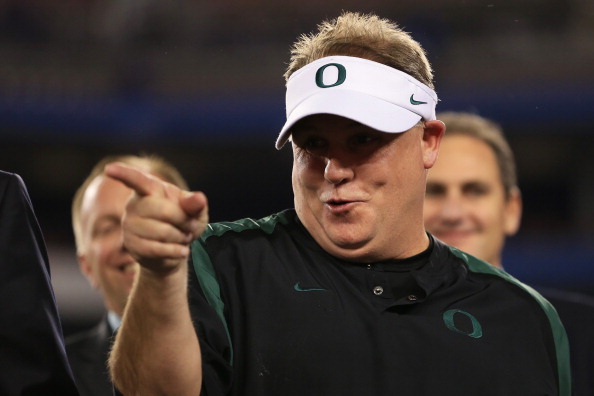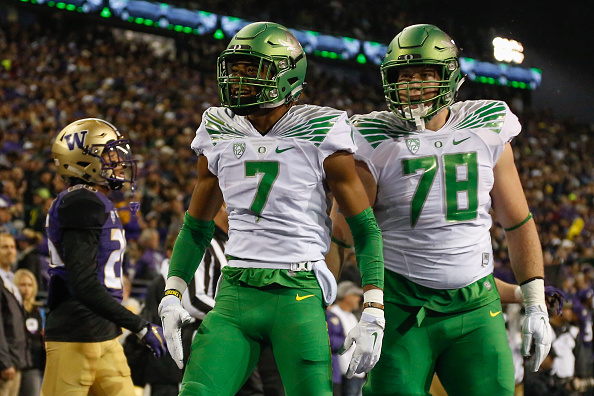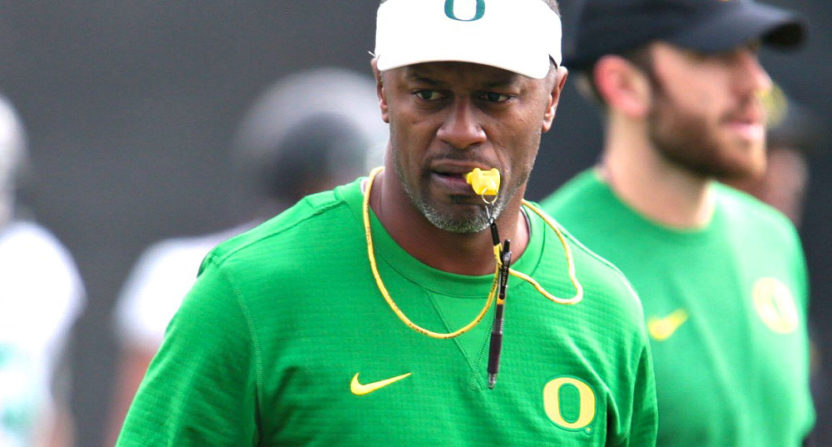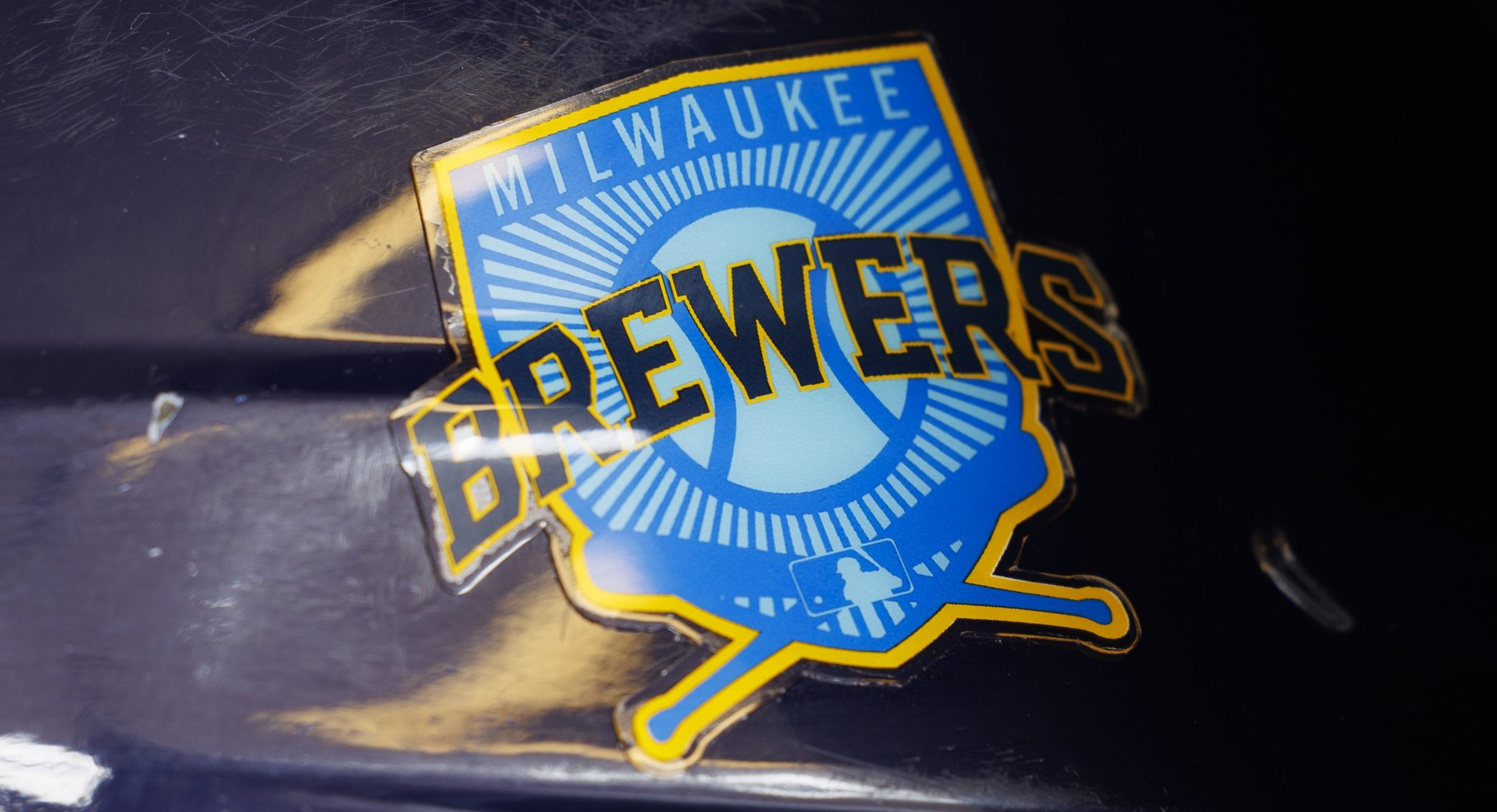Willie Taggart is the new king of the Nike castle at Oregon. His arrival comes after the sharp decline of a program among the elite just two short years ago. Can a head coach with little big-time coaching experience really catapult the Ducks back among the blue bloods of the sport?
The Making of an Elite Program
It wasn’t that long ago when Oregon was competing for national titles on a yearly basis. A program defined by a few short-lived flash in the pan years had turned into one that was among the top programs in the country.

From Mike Belotti’s embracing of the spread offense, to the seamless and upgraded transition to Chip Kelly, the Duck program was suddenly known as one on the cutting edge of all that goes with Nike money, outlandish facilities, and 3,234 uniform combinations. At least.
Recruits began to flock to Eugene to be a part of something cool, relevant and bigger than almost anything else out there.
That was then, this is now.
The Subtle, yet Major Shift
RT @jakezivin Oregon's next FB coach Mark Helfrich has arrived for his introductory press conference. Live on KEZI at 1 pic.twitter.com/fbbRgPrA
— KEZI 9 NEWS (@KEZI9) January 20, 2013
In January of 2013, Kelly decided to try his spread, up-tempo offense in the NFL. He bolted for the new challenge of coaching the Philadelphia Eagles. That left the program in transition, and the administration decided to go safe and hire from within by promoting offensive coordinator Mark Helfrich to the head spot. After all, it worked when Kelly was promoted from coordinator.
At first, it looked like a resounding success with Helfrich’s team going 11-2 in 2013, and then making its way to the first-ever College Football Playoff Championship game after the 2014 season. The Ducks lost to Ohio State, but Helfrich looked to be the right man for the job.
Then it happened.
The downward spiral that many predicted when Kelly left began to descend on the Oregon campus. The following year in 2015, the Ducks fell to an overall record of 9-4. Not bad, but not up to the high standards previously set. And last year, everyone seemed to go duck hunting, as Mark Helfrich’s crew finished a miserable 4-8.
There are a slew of reasons the program spiraled down so quickly, but we’ll get into that in just a moment.
Challenges Remain

After last year, the Oregon administration decided it was time to go in a new direction. On Dec. 7 of last year, Willie Taggart was hired as the guy in charge of getting Oregon back among the elite.
But is he up to the task?
It’s a much different world than when Kelly was beginning his swift ascent up the college football mountain top. The spread attack was not as commonplace as it is today, and certainly not at the break-neck speed that he brought to Eugene.
Now, the spread is the norm, not the exception. There are more and more teams that have carbon-copied the up-tempo style of the Ducks attack. And with it, defenses have more and more game film, more understanding of how to stop it, and more ways to keep up offensively. Ohio State, Alabama, Clemson, and many other top programs now use at least some components of what Kelly perfected.
In much the same way that spread guru Rich Rodriguez is a cautionary tale of the culture catching up to his ahead-of-the-curve zone-read offense, the Duck offensive attack is in danger of hitting the same pothole in the path it has blazed.
A Drop-Off in Talent
One of the other reasons Oregon became an elite program is because of a serious uptick in recruiting. A lot of it had to do with what Kelly was selling, but a lot of it also had a ton to do with the flashy Nike uniforms and facilities that came along with Phil Knight’s money.

From 2010 through 2012 when Oregon was at peak stature, it ranked 13th, 13th, and 15th respectively according to Scout.com. And that was when recruiting to a type that puts a premium on speed. After Kelly, from 2013 through last year, the classes were ranked 17th, 22nd, 21st, and 22nd. It’s not a huge dip, but enough of one to go from elite in the system it ran, to mediocre at best. It was felt most especially on the defensive unit where Oregon fell to 126th in the country in total defense last season.
Winning at style and pizzazz has lost its luster as well. Now many programs utilize “alternate” uniforms. The race for facilities and cool features have also evened out with other programs putting money into unique features that wow potential recruits. Kids no longer have to go to Nike U to be a part of Nike U. It’s just the evolution of the business.
Getting to Know Taggart
But back to Taggart. It was a bit of a surprise that the call went out to the Bradenton, Florida native in the first place. It’s one thing to turn around a Group of Five team. It’s another to steer a big ship with big-money boosters and big-time expectations. Truth be known, many around the program hoped the Ducks would be the winner of the Tom Herman sweepstakes.
But when Herman landed at Texas, the Oregon brass decided to pass over guys like Lane Kiffin, P.J. Fleck, Greg Schiano and others for what they believed Taggart brought to the table.
So let’s get to know Taggart, for those of you who aren’t familiar. Willie Taggart is actually a little bit of Jim Harbaugh and a little bit Chip Kelly to some degree. He played quarterback for Jim Harbaugh’s dad Jack at Western Kentucky. Taggart was later an assistant under Jim Harbaugh at Stanford. Heck, believe it or not, the younger Harbaugh was the best man at Taggart’s wedding. True Story. There’s no truth to the rumor though that Harbaugh was “bitterly disappointed” by the tuxedo choice though.
It’s no mystery then why the USF program was one built out of accountability, toughness, and “an enthusiasm unknown to mankind.” At least those are the words that appear around the football building at USF.
Now, where have we heard that before?
“Attack each day with an enthusiasm unknown to mankind.” – Jim Harbaugh https://t.co/2mzPQimPnp #WarriorMindset pic.twitter.com/5fgr0FNP6E
— Darrin Donnelly (@DarrinDonnelly) June 16, 2017
He’s His Own Man Too
But Taggart is more than Harbaugh. He’s not afraid to adapt and change away from the system that he started. He once used a pro-set offense at Western Kentucky and initially at USF. At both stops, he began and sustained modest turnarounds. But something was missing.
Looking for an edge, Taggart began utilizing the West Coast offense and liked the options and challenges it presented for opposing defenses. He then decided to expand it to the spread and went to several schools like Baylor, Auburn, Clemson, and Oregon itself to learn from what they had implemented.
As a result, his offense is basically the best of a collection of ideas and principles from all of those programs, and it resulted in USF having a whale of a season last year. In fact The Bulls had one of their most successful seasons ever. They got things crankin’ by going 11-2 and finishing as the co-champion of the American Athletic East division. They lost the tie-breaker to Temple because of a head-to-head loss, but were able to cap off the season with a win over South Carolina in the Birmingham Bowl.
The template, it appears, has been set. And then the phone rang.
What’s at Hand
ICYMI: ScoopDuck takes a closer look at the 'Gulf Coast' offense – How it will fit #GoDucks personnel (Free) https://t.co/Ftple1HesQ pic.twitter.com/2RBsVlgRHS
— Justin Hopkins (@JHopkinsSD) April 4, 2017
The move to the self-proclaimed Gulf Coast offense is what got Taggart the look from Oregon. The culture has long been set in Eugene and it’s unlikely that anyone associated with the program would ever want to go back to the dark ages of three wide-outs, let alone one-back and two tight-end sets.
And there’s reason to believe that the personnel on hand could set the new sheriff up for at least some modest improvement in year one. The defense was downright nausea-inducing in 2016, but at least a lot of the experience returns. The hope is that some hard lessons have been learned. There’s also optimism abounding that new defensive coordinator Jim Leavitt will be able to solve a lot of the warts on that side of the ball.
And the offense? Let’s just say that it once again has the potential to be very explosive. Royce Freeman returns as one of the most explosive running backs in the country.
In addition to a game-changer in the backfield, there is depth at wide receiver, and the line returns four freshman starters. They should be a year wiser and more able to protect sophomore quarterback Justin Herbert who showed signs of promise in 2016.
Bringing in the Goods
But how successful Taggart is down the road will ultimately come down to recruiting. He’s yet to have the keys to a big-time college program going against the likes of USC, Washington and the like. Needless to say, the jury is out on that one. The facilities will always be there, and Phil Knight will give any head coach of Oregon the closest thing to a blank check to bring in the wow factor. But Taggart still has to go out and seal the deal with recruits.
So far so good on that front, at least judging from what is being pieced together for the 2018 class (it would be unfair to judge the 2017). Of course things could change up until signing day, but Taggart and his staff have already gotten verbals from 15 kids. Nine of which are considered four-star talents. The class currently sits at sixth nationally.
That would be the highest-rated class in recent memory if things stay on course.
Potential Versus Reality
To this point, though, everything is hypothetical. It all gets real when things kick off on Sept. 2 against Southern Utah. It’ll get even more real when the Ducks travel to Stanford on Oct. 14. It’ll be downright scary traveling to Seattle to take on defending Pac-12 champ Washington on Nov. 4.
At the end of this rope, history will judge whether Willie Taggart is up to the task of restoring the luster of the Ducks program. Mediocre won’t get it with the raised expectations that comes along with where the program has been in recent years. And nobody knows that more than Taggart.
After a few short years, it’ll either be a program still out of its familiar waters, or one that’s once again on the forefront of innovation. Get ready Duck fans, because ready or not, Taggart is bringing his Gulf Coast offense to the Pacific Northwest.
Sometimes things that don’t fit, make the most sense of all.







